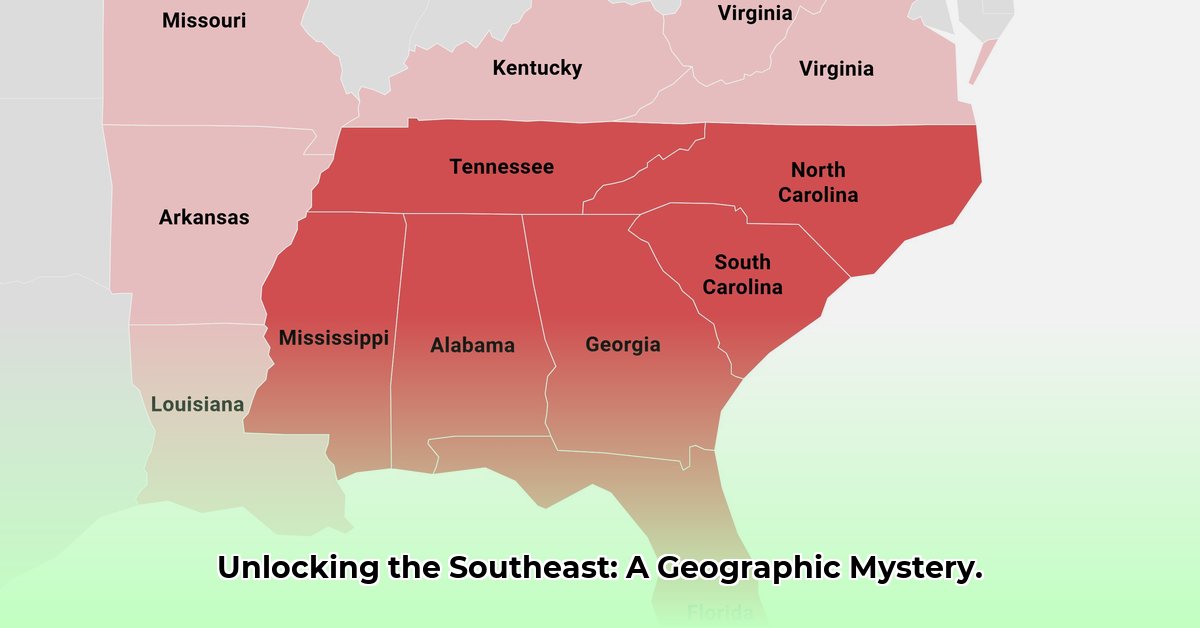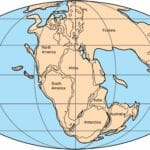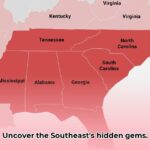Explore the Southeastern US—a vibrant region stretching from Florida’s sunny shores to the Appalachian Mountains’ majestic peaks. More than just lines on a map, it’s a story of how geography shapes the region’s economy, culture, and future. For a detailed visual representation, check out this Southeast US map. Discover the hidden secrets of this fascinating part of the United States and understand its geographic influences for a brighter future.
Southeast United States: A Geographic Exploration for Regional Planning
Delve into the captivating geography of the Southeastern United States—a region of such diversity that it eludes simple categorization. It’s a meeting place of rolling hills, towering mountains, sun-kissed coastal plains, and enigmatic swamps. This landscape is the key to informed planning and unlocking regional opportunities.
Defining the Southeast and its Flexible Boundaries
Pinpointing the exact boundaries of the Southeast can be surprisingly complex. The core states—Alabama, Florida, Georgia, Mississippi, North Carolina, South Carolina, and Tennessee—are universally recognized. Beyond these, the lines blur, with states like Arkansas, Kentucky, Louisiana, Virginia, and West Virginia sometimes included based on perspective and criteria. These “fuzzy” boundaries often reflect shared cultural traditions as much as defined geographical markers. Therefore, any map of the Southeast must acknowledge this inherent flexibility.
Climate and Diverse Landscapes of the Southeast
The Southeastern US boasts an incredibly varied landscape, a patchwork of distinct environments. Wide, flat coastal plains line the Atlantic and Gulf coasts, gradually rising into gentle hills that eventually meet the Appalachian Mountains. Major rivers like the Mississippi and Tennessee wind through the region, carving valleys and shaping the land. Extensive wetlands, from Florida’s Everglades to Louisiana’s bayous, enhance this richly textured landscape. This diverse geography directly influences the region’s climate—a generally humid subtropical climate frequently punctuated by powerful hurricanes. The interplay of these features defines the character of the Southeast.
Resource Distribution: The Land and Our Livelihoods
This rich tapestry of landscapes has profoundly shaped life and work in the Southeast. The fertile lands along the Mississippi River, for example, have supported a thriving agricultural industry for centuries—a national breadbasket visible on any agricultural map overlaid on the Southeast. The Appalachian Mountains, in contrast, rely on tourism, timber, and mineral extraction. Coastal communities face the constant threat of hurricanes, demanding robust infrastructure and disaster preparedness. The unique ecosystems of areas like the Everglades and Louisiana bayous require careful conservation—balancing human needs with environmental health.
Renewable Energy: Opportunities and Challenges in Regional Planning
The geographic diversity of the Southeast presents both challenges and opportunities. Hurricanes pose a significant threat, causing extensive damage to lives, property, and livelihoods. Resource management, especially water, is critical in this varied environment. Constructing infrastructure in mountainous terrain or hurricane-prone coastal zones can be particularly challenging. However, this diversity also offers incredible opportunities. Tourism thrives on the region’s natural beauty, and there is significant potential for renewable energy development, harnessing abundant sunlight and wind. Effective regional planning can transform obstacles into advantages.
Population Density: Planning for the Future
Successful regional planning in the Southeast demands an in-depth understanding of the region’s geography and its interaction with human activities. A detailed map of the Southeast, combined with data on population density, resource distribution, and disaster vulnerability, forms the foundation for smart decision-making. This includes building resilient infrastructure, adopting sustainable farming methods, and developing effective coastal protection strategies. These are not solely geographical issues; they directly impact the economy and shape the quality of life for the entire region. It’s about optimizing the use of the region’s unique geographic assets.
Coastal Protection: Collaborative Efforts
Here’s how different groups can contribute, both in the short and long term:
| Stakeholder | Short-Term Goals (0-1 Year) | Long-Term Goals (3-5 Years) |
|---|---|---|
| Government Agencies | Enhance hurricane preparedness; strengthen coastal defenses; invest in early warning systems. | Integrate climate change projections into long-term planning; invest in sustainable farming systems; enforce stricter building codes in vulnerable areas. |
| Tourism Industry | Develop targeted marketing campaigns showcasing resilience; improve infrastructure for accessibility. | Promote environmentally responsible tourism; invest in sustainable transportation options; support local conservation efforts. |
| Infrastructure Developers | Build more resilient structures in vulnerable areas using innovative materials and designs. | Create sustainable transportation networks; invest in renewable energy sources; implement green infrastructure solutions. |
| Agricultural Sector | Enhance soil conservation practices; adopt precision agriculture techniques to minimize waste. | Focus on climate-resilient crops; manage water resources responsibly; promote regenerative agriculture practices. |
| Conservation Organizations | Expand habitat restoration projects; promote responsible land management practices. | Advocate for stronger environmental protection laws; raise awareness about the effects of climate change; conduct research on ecosystem resilience. |
A thoughtfully interpreted map of the Southeastern United States is vital for navigating these complex challenges. It’s more than just a visual aid; it’s a dynamic tool for shaping the future of this extraordinary region. The Southeast’s future hinges on understanding and leveraging its unique geographic inheritance.
Mitigating Hurricane Risk in Southeastern US Coastal Development
Key Takeaways:
- Increasing hurricane intensity and frequency in the Southeast US necessitate a multifaceted mitigation strategy.
- Mitigating hurricane risk in southeastern US coastal development requires combining structural solutions (e.g., improved levees) with natural defenses (e.g., mangrove restoration).
- Effective mangrove restoration depends on factors like species selection, ecosystem context, and project scale.
- Levee effectiveness is site-specific and often requires supplementary flood control measures.
- Long-term financial liabilities from hurricane damage and the adequacy of federal resources present significant policy challenges.
Southeastern US Landscape and Natural Disaster Vulnerability
The Southeastern US features a diverse geography – from sprawling coastal plains to the Appalachian Mountains. These landscapes influence the climate, shaping communities and economies. Coastal areas are particularly vulnerable to increasingly powerful hurricanes. Fertile river valleys support agriculture, vibrant coastal cities thrive on tourism, and inland mountains offer stunning natural beauty. The recurring threat of hurricanes significantly impacts all of these.
Economic Impact of Hurricanes
Hurricanes serve as a stark reminder of nature’s power, with wide-ranging impacts on communities, economies, and cultural practices. The damage extends beyond immediate destruction, encompassing long-term economic effects, disruption of daily life, and prolonged rebuilding processes. Rising sea levels and warming ocean waters exacerbate these challenges.
Strategies for Coastal Resilience
So, how can hurricane risk be mitigated in southeastern US coastal development? A comprehensive approach is essential:
- Structural solutions: Strengthening building codes, investing in robust infrastructure (such as improved levees and seawalls), and developing resilient building techniques are crucial.
- Natural defenses: Restoring and protecting coastal ecosystems, particularly mangrove forests, provides a natural buffer against storm surges and flooding.
- Community engagement: Educating communities, enhancing early warning systems, and promoting community-level disaster preparedness are vital for saving lives and minimizing damage.
- Land-use planning: Implementing careful land-use planning can limit development in high-risk areas, directing growth to safer locations.
Long-Term Vision: Community Resilience
Finding a long-term balance between infrastructure and the natural environment is paramount. We must consider the environmental consequences, minimizing the negative impact of development while ensuring community safety and survival. Mangroves, for instance, provide a powerful natural barrier for coastal areas. Investing in their restoration is crucial for storm mitigation, biodiversity, and ecosystem preservation.
Addressing Policy Challenges and Financial Implications
Federal and state governments, alongside the private sector, have a critical role to play. This includes reforming programs like the National Flood Insurance Program (NFIP) to address long-term solvency in the face of escalating climate change. Coordinating resources and strategizing effective responses are critical undertakings.
Addressing policy challenges and financial implications by including funding for community-based resilience projects.
Sustainable Development Tactics for Southeastern US Coastal Regions
Key Takeaways:
- Climate change significantly impacts the Southeastern US coastline, threatening habitats and communities.
- Effective coastal resilience requires a combined approach: natural solutions, strategic planning, and robust stakeholder collaboration.
- Balancing environmental protection with economic development is crucial for successful Sustainable Development Tactics for Southeastern US Coastal Regions.
- Ongoing monitoring, data sharing, and sustained community engagement are vital for long-term success.
Ecosystem Preservation: A Portrait of the Southeast
The Southeastern US coastline is formed by diverse features: coastal plains, mountain ranges, river systems, and vital wetlands. This geography shapes the region’s climate, influencing agriculture and hurricane vulnerability. The Mississippi River Valley contrasts with the Appalachian Mountains. Along the coast, barrier islands and estuaries highlight the sensitivity of these ecosystems to sea-level rise and storms.
Environmental Damage and Preservation Strategies
Coastal erosion poses another significant threat, demanding innovative solutions like beach nourishment and the construction of living shorelines.
















